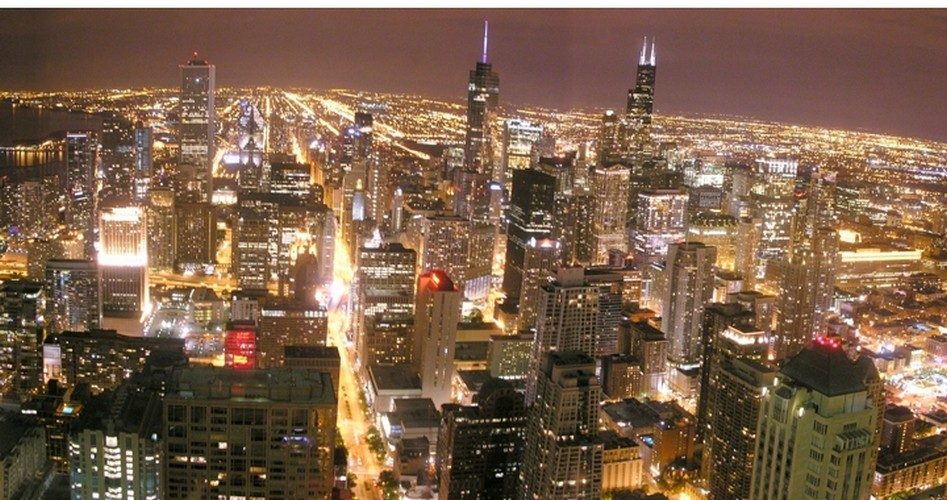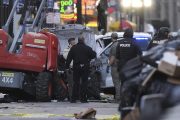
The streets of Chicago ran red with blood the weekend of August 24. Nine were dead and 28 wounded after a four-night orgy of gunfire and violence. The mayhem began Thursday, August 23 and ran into Friday, August 24 with 19 people shot. But it continued through Sunday night August 26. The shocking toll for the weekend, including August 23, is 47 wounded.
Last month, The New American reported that the City with the Big Shoulders was set to reach 504 murders, surpassing last year’s total, if the pace of killings continued. It appears as if the city’s more violent residents seem set to push the number even higher.
Three Days of Gunfire
The lead began flying on August 23, the Chicago Tribune reported the next day. “Nineteen people were shot across the South and West sides from Thursday evening through early Friday morning — 13 of them wounded over a 30-minute period, authorities say,” the Tribune reported.
The overnight shootings peaked between 9:15 p.m. and 9:45 p.m. That’s when eight people, many of them teens, were shot at 79th Street and Essex Avenue about 9:30 p.m.
Those eight unfortunate people were hit with gunfire in a drive-by shooting, the Tribune reported. “The shooting likely stemmed from a conflict between two factions of a gang that uses 75th Street as a dividing line, according to police, who said some of the wounded people were not cooperating,” the newspaper reported.
But the multiple shootings that occurred elsewhere in the city occurred in a narrow, half-hour window. After the first eight, two men were wounded, one in the head and another in the right arm, police told the newspaper.
Around the same time, two other men were wounded in the arms in a drive-by shooting.…
About 15 minutes later, a 24-year-old man was shot in the leg.… The man told police he was talking on his phone when he heard a single shot and realized he was wounded.
Drive-by gunfire hit another five, while the 19th victim was shot by someone who approached him on the street.
And that was just Thursday into Friday. Through the weekend, the violence continued unabated.
Nine More Dead
The Chicago Sun-Times called the roll of victims. As with the previous day’s shooting, people firing from cars killed several people. According to the Sun-Times, “One of the youngest victims reported by police was a 15-year-old girl, who suffered a gunshot wound to the chest Friday night as she smoked marijuana in the Roseland neighborhood on the Far South Side.”
The girl and a teenage boy were hanging out in the 0 to 100 block of West 112th Street when the boy moved a gun and it fired, police said. Paramedics took the girl to the University of Chicago Comer Children’s Hospital, where she was listed in critical condition, authorities said.
“Chicago Police Supt. Garry McCarthy on Saturday defended the department’s anti-violence strategy, which he believes is taking root,” the Sun-Times reported.
“We’re not winning, we’re not losing. We’re basically treading water,” McCarthy said. He said that in the month of August, “we had some trouble because some of these retaliatory shootings are happening quicker than we can stop them.”
Aside from the practical problem of combating the violence, police must grab the more vexing nettle of persuading witnesses and victims to cooperate, the Chicago Tribune reported on August 27. In more than three-quarters of the cases, the newspaper found, police get very little information because no one wants to talk. So they suspend the cases.
“Chicago police have suspended nearly 80 percent of their investigations into nonfatal shootings on the grounds that victims wouldn’t cooperate, according to a review of more than 1,100 cases through the first seven months of the year,” the Tribune reported.
Quoting a detective who said a “no-snitch” code rules the streets, the Tribune divulged that “Through the first seven months of 2012, there were 1,165 nonfatal shooting cases in Chicago, according to police records reviewed by the Tribune.”
Investigations into 75.9 percent of those cases have been classified as “suspended” because the victims declined to cooperate with police, the statistics show. An additional 4.4 percent of cases have been designated “exceptional cleared closed,” meaning police have identified a suspect, but victims have declined to cooperate with a prosecution.
Homicide Totals
Chicago murders are up about 31 percent from last year, the Tribune reported.
RedEyeChicago.com runs a monthly tally of killings, as The New American reported late last month. On August 27, RedEye reported that Chicago had tallied 51 homicides for August, thanks to the weekend of killings.
That means the “city has recorded 356 homicides so far this year, 29 percent more homicides than were logged at the same time last year,” the website reported. Last year, Chicago did not post 350 homicides until Oct. 23, the website reported.
While the city has suffered 51 homicides so far in August, the website noted, “Two months this year have seen 50 or more homicides: March, which saw 50, and May, which saw 51. One month last year saw more than 50 homicides: July 2011, which saw 55 homicides.”
When The New American published its story about homicides in the city, it had posted 37 for July. By the month’s end, another 11 homicides were recorded, bringing the the body count up to 48.
The figures for 2012 are truly grim: 40 murders in January, 28 in February, 50 in March, 41 in April, 51 in May, and 47 in June.
The New American estimated that Chicago might well reach 504 homicides, or 42 per month, if the monthly average at that time continued. But with another 11 homicides before July closed, another 51 this month, that prediction might be too optimistic.
Thus far, at 356 murders, the average is 1.48 per day. At that rate, by year’s end the number of homicides could top 540, a 25 percent increase over the total for 2011, 433.
But even that number would be a dramatic decrease from the early 1990s, when the number of murders in the Windy City thrice topped 900: 928 in 1991, 943 in 1992 and 931 in 1994. From there, the number steadily dropped until they reached the 20-year low of 433 in 2011.
But that is no comfort for the people living in what has become a veritable war zone between the gangs responsible for almost all of the shooting and killing. For instance, 42 died and 188 were wounded in just five weekends between February and May and including July 4.
Sadly, almost all this violent crime occurs in black neighborhoods, the data show. “A majority of both homicide victims and offenders are young black men with criminal records,” the Tribune reported. “With one exception, African-Americans have made up more than 70 percent of homicide victims in Chicago every year for the last two decades.”
In June, the New York Times reported that other big cities, notably Philadelphia, the city of Brotherly Love, face an increase in murders similar to Chicago’s.
Related Story:



